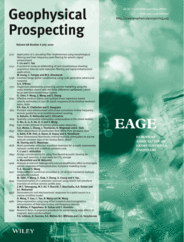
Full text loading...
 , Yongxin Gao1, Cheng Yao1, Baozhen Wang1, Mengqiang Wang1
, Yongxin Gao1, Cheng Yao1, Baozhen Wang1, Mengqiang Wang1
We investigate the seismoelectric/electroseismic wavefields excited by a point source in an air/seawater/three‐layered porous medium configuration containing a hydrocarbon layer. The results show that if an explosive source for excitation is used, receivers at seafloor can record the coseismic electromagnetic fields accompanying the P, S, fluid acoustic waves and the interface responses converted from the acoustic waves at seafloor interface and from the seismic waves at the interfaces beneath the seafloor. Employing a vertical electric dipole source shows that, with the exception of the interface responses converted from electromagnetic waves at seafloor, the interface responses converted from transmitted electromagnetic waves at the interfaces beneath the seafloor can also be identified. Given that the strength of the explosive source is within excitation capability of industry air guns, the generated interface responses from the hydrocarbon layer can be detected by current electromagnetic sensors considering the low ambient noise at the seafloor. Our results demonstrate the feasibility of the seismoelectric method applied to marine hydrocarbon exploration. Electroseismic modelling results suggest that it is not practical to employ this method to prospect marine hydrocarbon layer due to the weak interface response signal, unless a much larger current is injected into seafloor.

Article metrics loading...

Full text loading...
References


Data & Media loading...

